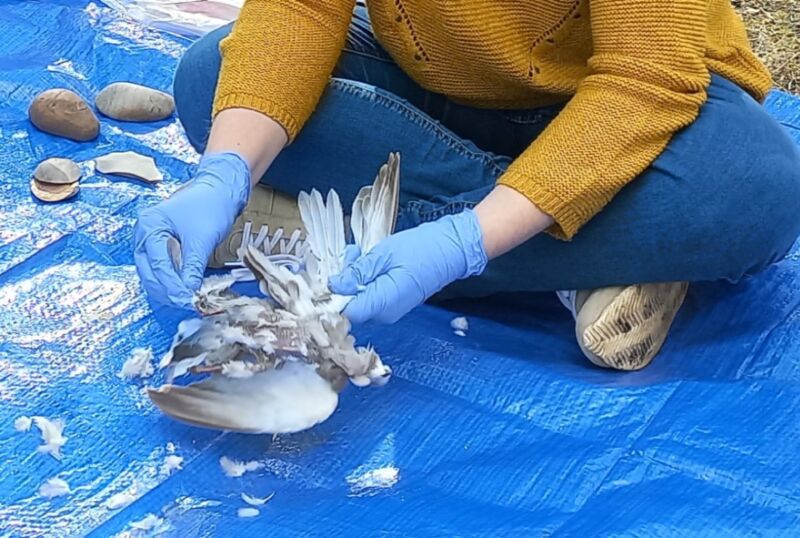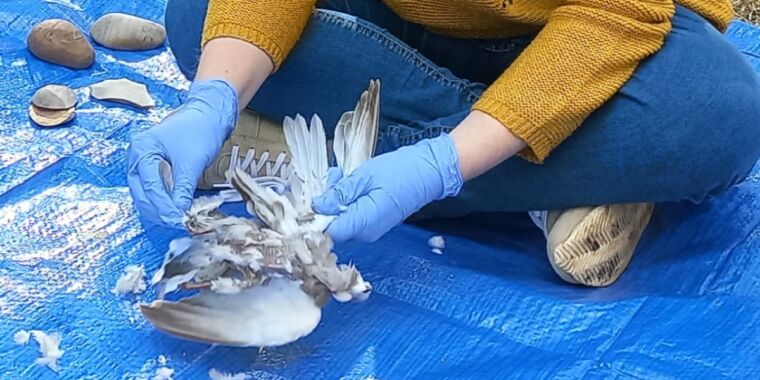
Mariana Nabais
Archaeologists interested in learning more about how Neanderthals prepared and cooked their food conducted a series of hands-on experiments with small birds, using flint flakes to butcher them. They found that the flint flakes were surprisingly effective at butchering the birds, according to their new paper published in the journal Frontiers in Environmental Archaeology. They also concluded that roasting the birds damaged the bones enough that they would be unlikely to be preserved in the archaeological record.
According to the authors, Neanderthals were able to survive for more than 200,000 years in a wide range of geographic regions, so archaeologists are naturally interested in how they sustained themselves. Studies have been done on their killing and hunting big game. Neanderthals were expert hunters, known for killing bears and other carnivores. A pair of lion fibulas from the Middle Paleolithic found in eastern Iberia with cut marks indicate that the lion was butchered, while other lion bones found in southwestern France from the same period had cut marks indicating skinning.
And as we reported last year, researchers found evidence of what may be the earliest example of lion hunting yet. This evidence was based on a thorough forensic analysis of a cave lion skeleton, which revealed marks from a wooden spear that dates back some 48,000 years.
The team tested their hypothesis by reconstructing the ballistics of a wooden-tipped spear's impact on the rib, comparing the direction, angle of impact, and depth of penetration. Based on these, it appears that the spear passed through the left side of the cave lion's abdomen and vital organs before hitting the right side of the rib. The same study also found claw bones from cave lions that showed evidence of having been skinned around 190,000 years ago.
However, smaller game like birds have received much less attention. Still, “birds provide a supplementary food source that may have played a critical role in Neanderthal adaptation and survival,” wrote co-author Mariana Nabais of the Institut Catala de Paleoecologia Humana i Evolucio Social in Spain and her colleagues. So they designed a pilot study that simulated early human cooking and butchering methods to provide a baseline, and compiled a database of telltale markings that could help archaeologists better analyze artifacts by comparing marks on those markers to the database.
Roasting birds on an open fire
Nabais et al. collected frozen bird specimens that had died under natural conditions in a nature reserve in Portugal, and selected species that taxonomically would represent the Neanderthals that would have likely hunted the Iberian Peninsula: carrion crow, wood pigeon, and collared dove. All five specimens were defeathered.
Two were butchered uncooked, using a replica flint (made by students) where necessary; the techniques used were derived from archaeological evidence and ethnographic data. The scientists cleaned and dried the bones, and examined them under a microscope for characteristic cut marks, fractures and burns. They also analysed the flint for telltale wear, finding small crescent-shaped scars on the edge.
-
Wear and tear on the flakes used in slaughtering.
Marina Igreja
-
Bones found from the birds.
Mariana Nabais
“Using a flint flake for butchery required considerable precision and effort, which we had not fully appreciated before this experiment,” Nabais said. “The flakes were sharper than we initially thought, requiring us to be careful to make precise cuts without injuring our own fingers. These hands-on experiments highlighted the practical challenges associated with Neanderthal food processing and cooking, and provided a tangible connection to their daily lives and survival strategies.”
The other three birds were roasted whole (unsexed) on hot coals at 500° C: first on their bellies for four minutes, then turned over and roasted for another three minutes. The team was careful to maintain a constant temperature and monitor the cooking time so as not to overcook the meat. “Perhaps because we defeathered the birds before cooking them, the roasting process went much faster than we expected,” Nabais said. “We actually spent more time preparing the coals than we did the actual cooking, which took less than 10 minutes.”
The team also analyzed the bones of the cooked birds. In the former, those bones were much more brittle—some were broken—and nearly all had black or brown burn marks, as well as black stains in the inner cavities of some bones. “Because burned bird bones are prone to breakage and loss, roasting activities may therefore go unnoticed at archaeological sites,” the authors wrote. “Such observations suggest that cooking practices significantly affect the preservation of skeletal remains in archaeological contexts, potentially influencing the archaeological visibility of certain cooking practices.”
Nabasi et al. stressed that this is only a pilot study with a very small sample size and limited species; the types of birds Neanderthals ate may have been more diverse. And despite their careful control of experimental conditions, it is simply not possible to exactly replicate Neanderthal methods, real-world conditions, and broader cultural contexts. They called for further research, expanding the experiments to more bird species and different cooking methods.
Frontiers in Environmental Archaeology, 2024. DOI: 10.3389/fearc.2024.1411853 (About DOIs).

